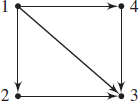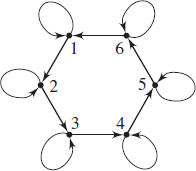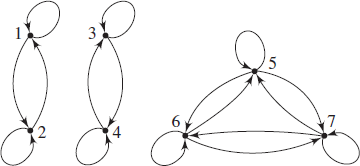MA225- Exam 3 Prep
1/28
There's no tags or description
Looks like no tags are added yet.
Name | Mastery | Learn | Test | Matching | Spaced |
|---|
No study sessions yet.
29 Terms
Define what it means for a function to be Reflexive.
R is reflexive on 𝐴 if for all 𝑥∈𝐴, xRx.
Ex: S = {(x,y) ∈ R x R: x² = y²}
Proof
Let x be a real number. Then x²=x². Therefore xSx. Thus, S is reflexive on R.
Define what it means for a function to be Symmetric.
R is symmetric on 𝐴 if for all 𝑥,y∈𝐴, if xRy, then yRx.
Ex: S = {(x,y) ∈ R x R: x² = y²}
Proof
Assume that x and y are real numbers and xSy. Then x²=y². Therefore, y²=x². Thus ySx. We can conclude that S is symmetric on R.
Define what it means for a function to be Transitive.
R is transitive on 𝐴 if for all 𝑥,y,z∈𝐴, if xRy and yRz, then xRz.
Ex: S = {(x,y) ∈ R x R: x² = y²}
Proof
Assume that x, y, and z are real numbers and that both xSy and ySz. Then x²=y² and y²=z². Therefore, x² must also equal z². Thus, xSz. This proves that S is transitive on R.
When is a relation an Equivalence Relation?
When the relation is reflexive, symmetric, AND transitive.
What is the definition of a Function?
If and only if f is a subset of AxB and (x,y), (x,z) are elements of f is f a function.
What is the definition of a Function from A to B?
A function (or mapping) from A to B is a relation 𝑓 from A to B such that:
(i) the domain of 𝑓 is A
(ii) if (x,y) ∈ 𝑓 and (x,z) ∈ 𝑓, then y = z
𝑓: 𝐴→𝐵 is read as “𝑓 is a function from 𝐴 to 𝐵” or “𝑓 maps 𝐴 to 𝐵”. The set 𝐵 is called the codomain of 𝑓. In the case where 𝐵=𝐴, we say 𝑓 is a function on 𝐴.
When (x,y) ∈ 𝑓, we write y = f(x). We say that y is the image of 𝑓 at x and that x is a pre-image of y.
What makes a function Injective?
A function 𝑓 : 𝐴→𝐵 is an injection (or one-to-one) if whenever 𝑓(x)=𝑓(y), then x=y.
What makes a function Bijective?
A function 𝑓 : 𝐴→𝐵 is a bijection (or a one-to-one correspondence) if 𝑓 is one-to-one onto B.
What makes a function Surjective?
A function from A to B is a surjection (or onto B) if Rng(𝑓) = B. When 𝑓 is a surjection, we write that 𝑓 : A onto B.
Prove the Following Theorem (4.3.1):
If 𝑓 : 𝐴→𝐵 is onto 𝐵 and 𝑔 : 𝐵→𝐶 is onto 𝐶, then 𝑔∘𝑓 is onto 𝐶.
Prove the Following Theorem (4.3.3):
If 𝑓 : 𝐴→𝐵 is one-to-one and 𝑔 : 𝐵→𝐶 is one-to-one, then 𝑔∘𝑓 is one-to-one.
Assume the (𝑔∘𝑓)(x) = (𝑔∘𝑓)(z). Thus 𝑔(𝑓(x)) = 𝑔(𝑓(z)). Because 𝑔 is one-to-one, we have that 𝑓(x) = 𝑓(z). Because 𝑓 is one-to-one, we have that x = z. Therefore, 𝑔∘𝑓 is one-to-one.
Prove that the composite of two functions is a function.
Question 6a (Page: 172-173)
Prove the relation is an equivalence relation. Then give information about the equivalence classes as specified.
The relation S on R given by xSy iff x-y ∈ Q. Give the equivalence classes of 0, 1, and Sqrt(2).
Question 6b (Page: 172-173)
Prove the relation is an equivalence relation. Then give information about the equivalence classes as specified.
The relation R on N given by mSn iff m and n have the same digit in the tens place. Find an element of 106 that is less than 50; between 150 and 300; greater than 1,000. Find three such elements in the equivalence class 635.
Question 6c (Page: 172-173)
Prove the relation is an equivalence relation. Then give information about the equivalence classes as specified.
The relation V on R given by xVy iff x=y or xy=1. Give the equivalence classes of 3, 0, and -2/3.

Question 8a (Page: 172-173)
Does the digraph represent a relation that is reflexive on the given set, symmetric, or transitive?

Question 8b (Page: 172-173)
Does the digraph represent a relation that is reflexive on the given set, symmetric, or transitive?

Question 8c (Page: 172-173)
Does the digraph represent a relation that is reflexive on the given set, symmetric, or transitive?
Question 9a (Page: 172-173)
Determine the equivalence classes for the relation of congruence module 2.
Question 9b (Page: 172-173)
Determine the equivalence classes for the relation of congruence module 8.
Question 9c (Page: 172-173)
Determine the equivalence classes for the relation of congruence module 1.
Question 10a (Page: 172-173)
Name a positive integer and a negative integer that are congruent to 0 (mod 5) and not congruent to 0 (mod 6).
Question 10b (Page: 172-173)
Name a positive integer and a negative integer that are congruent to 0 (mod 5) and congruent to 0 (mod 6).
Question 10c (Page: 172-173)
Name a positive integer and a negative integer that are congruent to 2 (mod 4) and not congruent to 8 (mod 6).
Question 1b (Page: 209-211)
Is the following relation a function? If so, give the domain and two sets that could be a codomain.
{(1,2),(1,3),(1,4),(1,5),(1,6)}
Question 1c (Page: 209-211)
Is the following relation a function? If so, give the domain and two sets that could be a codomain.
{(1,2),(2,1)}
Question 3a (Page: 209-211)
Identify the domain, range, and another possible codomain for each of the mapping below. Assume that the domain is the largest possible subset of R.
{(x,y) ∈ RxR: y = 1/x+1}
Question 3b (Page: 209-211)
Identify the domain, range, and another possible codomain for each of the mapping below. Assume that the domain is the largest possible subset of R.
{(x,y) ∈ RxR: y = x²+5}
Question 3c (Page: 209-211)
Identify the domain, range, and another possible codomain for each of the mapping below. Assume that the domain is the largest possible subset of R.
{(x,y) ∈ RxR: y = tan(x)}